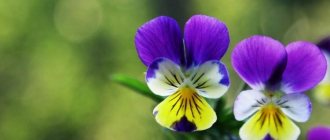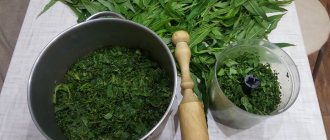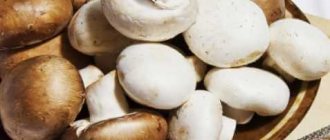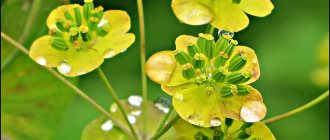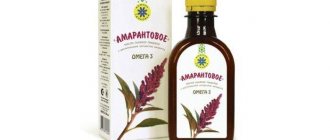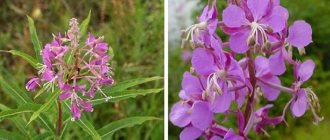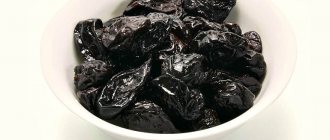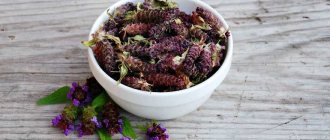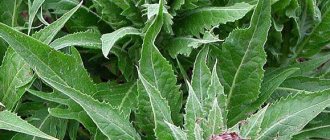Description of the flower
Ivan da Marya is an annual herbaceous plant that grows up to half a meter in height. The root system has specific suckers, thanks to which the flower attaches to other vegetation and lives on its juices. The erect stem, covered with white hairs, is characterized by branches. The ovate-lanceolate leaves are distinguished by their long-pointed shapes.
Each yellow flower is additionally decorated with a bract leaf of blue, violet, crimson or bright lilac color. At the end of the flowering period, which lasts throughout the summer, egg-shaped fruits are formed. Subsequently, the oblong seeds contained in the boxes serve as food for forest inhabitants.
Collection and healing properties of herbs
The entire above-ground part of Ivan da Marya as a medicinal product The collection begins in late spring and ends in September. Initially, the collected material is dried in a well-ventilated area and subsequently stored separately from other herbs. It is also worth remembering that oakberry maryannik very quickly loses its qualities and is suitable for beneficial use during the first ten months.
In medicine, the herb is used as a wound healing and anti-inflammatory agent. The prepared decoction of Ivan da Marya is used for heart and stomach diseases. Adding a medicinal plant to baths helps get rid of rheumatism, eczema and skin tuberculosis.
Effective recipes using the flower:
- A decoction based on oak grass will help get rid of skin rashes, scabies or scrofula. To prepare, dilute 3 tbsp per liter of boiled water. spoons of medicinal herbs. After two hours, the infusion is filtered and added to the bath or used for local rubbing.
- To treat hypertension, heart disease, to get rid of frequent dizziness and epilepsy attacks, the concentration of ingredients changes. In this case, 1 tbsp. l. Ivan da Marya is poured with a glass of boiling water, left for about half an hour and filtered. For effective treatment, drink the decoction twice a day, half a glass.
- The crushed young plant, as well as Ivan da Marya powder, promotes rapid healing of wounds.
Article on the topic: Chinese nettle - beneficial properties, description
Contraindications for use
When faced with the need to use ivan da marya in treatment, it is always important to remember the toxic qualities of the herb . This primarily applies to oral use. Aucubin (glucoside rhinantine), contained in the seeds of the herb, has an irritating effect on the body, which is most often expressed by feelings of weakness, decreased cardiac activity, and constant drowsiness. If these symptoms appear after using drugs based on Ivan da Marya, be sure to consult a doctor.
Use in folk medicine
In folk medicine, the above-ground parts of this herb are used for the preparation of medicines:
- flowers;
- fruit;
- leaves;
- stems.
Possible danger
But you need to use the plant only according to the instructions, otherwise it can cause harm to your health. Main symptoms of overdose and poisoning:
- stomach pain;
- weakness and drowsiness;
- vomiting and nausea;
- reduction in heart rate.
If a person is faced with the need to use this flower, then one should not forget about its toxic properties. Seeds are especially dangerous. They have a narcotic effect, cause drowsiness and irritability. If the above symptoms appear, you should consult a doctor.
Indoor variety of Ivan da Marya
Mariannik oakberry is a representative of wild vegetation, although this does not prevent avid flower growers from calling other types of indoor plants after Ivan and Marya. One of these varieties is tuberous begonia, also called campanula or “bride and groom”. A home flower differs from its own in many ways:
- appearance. Tuberous begonia blooms almost all year round, and therefore will act as a decoration for any type of interior. The plant is represented by two types of flowers: double, similar to rose buds, and ordinary, consisting of 4-5 petals;
- relate to perennial vegetation;
- Propagated not only by seeds, but also by cuttings.
In its natural form, Ivan-da-Marya is perfect for decorating border compositions made of stone or boulders.
But given the fact of the semi-parasite, not many people decide to leave the oak grove in their garden plots.
IVAN-DA-MARYA
DESCRIPTION, USEFUL PROPERTIES, APPLICATION AND RECIPES OF PRODUCTS FROM IVAN-DA-MARYA
DESCRIPTION OF IVAN-DA-MARYA Ivan-da-Marya is known as a herbaceous plant, which is often called tricolor violet . It is also known as pansy, brother, earthflower, ball, magpie's eye and triflower. The plant is widespread in the forest zone of the European part. It often grows among bushes, in open spaces, in meadows and as a weed in fields and vegetable gardens. Prefers fertile soils, but is also found on dry, gravelly soils on mountain slopes.
IVAN-DA-MARYA - COLLECTION AND PREPARATION As a medicinal plant, tricolor violet was known in ancient times. Currently, it is well studied and used in medicine. The grass is harvested as a medicinal raw material during the flowering period. It is cut at a short distance from the ground and dried in the shade in the open air. The grass contains saponins, flavone glycosides, rutin, tannins, essential oil, carotene, vitamin C. Along with this, field violet, which has only yellow flowers (grows in Eastern Siberia), is also harvested.
IVAN-DA-MARYA - FOLK TREATMENT Medicines made from violets treat skin rashes, pustular skin diseases, itching, eczema and scrofula. They are also used as a diaphoretic and cough suppressant and for the treatment of bronchitis, acute respiratory infections, rheumatism, gout, and atherosclerosis. In Transbaikalia, tuberculosis, lobar pneumonia and purulent pleurisy are treated with an infusion of variegated violet roots.
IVAN-DA-MARYA - INSTANCE Preparation of the infusion: 2 teaspoons of dry crushed raw materials are poured with a glass of boiling water and filtered after cooling. A glass of infusion is drunk in small portions throughout the day, and if nausea occurs, within two. Read more about the preparation of medicinal infusions in the article “ Healing teas and infusions .”
Article on the topic: Swamp mytnik - useful properties, description
Collection, drying, storage features of kusharka
In the preparation of home medicines, the entire above-ground part of the oak grove is used - leaves, shoots, flowers, seeds. You should collect kusharka during the flowering period, throughout the summer. The seeds are usually collected in early autumn, before the fruits crack.
Wash the harvested kusharka greens at home, dry them, lay them out (it is recommended to chop them into large pieces first) on baking sheets, lattices, covered with gauze cloth and paper.
Article for you:
Jujube: beneficial properties and contraindications
To dry, send plant materials to the attic, under covered sheds. Provide good ventilation - in a closed room, grass particles will begin to rot.
If it is not possible to use the attic for drying or carry out the process in the fresh air, it is recommended to send the baking sheets with herbal particles to the oven. At a temperature of 40-50 degrees, it will take several hours to dry the greens.
It is prohibited to exceed the temperature regime - beneficial substances will begin to deteriorate, the medicinal properties will significantly decrease, and there is a risk of concentration of harmful elements.
After drying, place the kusharka in small containers that are tightly buried - glass jars, plastic trays. Use cardboard boxes or linen bags only in a dry, warm room.
Be sure to store away from direct sunlight and heat sources. The shelf life of Ivan-da-Marya is up to two years. During storage, periodically check the condition of the plant material; if the particles are damp, dry them again.
Ivan da Marya flower: beneficial properties
Ivan da Marya is a name that is used in relation to several completely different types of plants. This name can be given to tricolor violet, meadow sage, periwinkle, and Geneva violet, but most often this name is used to understand oak grass.
It is also called Ivanets, brother and sister, bicolor. This is an annual semi-parasite from the Broomrapaceae family. The plant is highly ornamental, honey-bearing, but poisonous; as a medicinal plant it is used exclusively in folk medicine.
Useful properties of the flower
Ivan da Marya is widely used as a medicinal plant. Its anti-inflammatory, wound-healing and antiseptic properties have long been known. It is used externally, as lotions, and for preparing baths, as well as internally, in the form of decoctions .
Ivan-da-Marya has anti-inflammatory, insecticidal and wound-healing effects
Fruits and aerial parts are used. To prepare the herbal mixture, the plant is harvested during flowering. The collected raw materials are dried in a shaded, well-ventilated place and stored for no more than 10 months .
Flower Ivan da Marya: description
Ivan da Marya is a semi-parasitic herbaceous plant with a branched, straight stem 15 to 60 cm high. A parasite on willow, alder, spruce, hazel, and also on herbaceous plants. The stem is covered with white hairs facing downwards. The leaves are opposite, ovate, lanceolate-pointed, heart-shaped at the base, narrowed into a small petiole.
The inflorescence is an apical, sparsely colored spike-shaped raceme. The bracts are opposite, ovate-cordate, pointed with denticles, pubescent at the base and along the veins. The bracts of the lower part of the inflorescence are green, the middle part is blue-violet at the base, the upper part is completely purple.
The calyx is tubular with long-pointed teeth (approximately half the length of the calyx). The flowers are irregular, the pedicels are small, pubescent, facing one direction. The corolla is two-lipped, yellow, with a reddish tube and lower lip.
Flowering period is from May to September. It grows in clearings and forest edges, in oak forests, among bushes, and in swampy meadows.
The flower received its popular name due to the sharp contrast of the yellow corolla and purple bracts. There are many types of legends that explain this phenomenon, and they are all united by the plot of the tragic love of the young man Ivan and the beautiful Marya (in earlier versions - Kupala and Kostroma).
The yellow color of the flower was attributed to the boy, and the purple color to the girl. The reasons why young people’s fates did not work out differ from story to story, but since then these interesting bright flowers have been growing and delighting people.
It is not a pharmacopoeial plant, although it is considered promising for pharmacological research. Popular use of the Ivan and Marya flower as an insecticidal, anti-inflammatory and wound-healing agent is known. On the farm, a decoction of the seeds was previously used to dye fabrics yellow, as well as to fight insects.
Benefits and harms to human health
The plant is poisonous. Its terrestrial part contains alkaloids and glycosides, including aucubine and dulcite. Especially poisonous seeds. It can also cause severe poisoning in animals that eat it. Take orally with caution.
The benefits of the Ivan and Marya flower for the body are known for diseases of the heart, gastrointestinal tract and stomach, hypertension, epilepsy, and neuralgia. Externally it is recommended to use it for scabies, diathesis, skin tuberculosis, rashes, rheumatism, and for washing wounds. Marjannik tea is drunk for scrofula.
It must be used exactly according to the instructions. Failure to comply with the dosage may cause harm to a person. The main manifestations of overdose and poisoning:
- weakness;
- pain in the stomach, behind the sternum;
- nausea and vomiting;
- drowsiness;
- weakened cardiac activity.
Treatment in this case: gastric lavage, sorbents, if necessary - symptomatic therapy (caffeine, validol, nitroglycerin, etc.).
It has been scientifically proven that the infusion of the Ivan da Marya flower is characterized by a calming effect, similar to that of tranquilizers. It will be useful for treating the initial stage of epilepsy.
Contraindications
It has no precisely defined contraindications, but as a poisonous plant it is not recommended for use internally by pregnant women, children and those with individual intolerance.
Article on the topic: Clintonia uda - useful properties, description
Application of the herb Ivan da Marya
Extracts of the Ivan and Marya flower have antipsychotic properties. They have sedative, hypotensive cardiac, and anticonvulsant effects. Externally used for skin diseases, powder from a dried plant, as well as juice from a fresh one - for healing wounds.
For skin diseases
The plant Ivan and Marya has long been used for skin diseases: rashes of various etiologies, eczema, skin tuberculosis, demodicosis, scabies, scrofula. For baths and local washings, an infusion is used.
Tincture recipe: 3 tablespoons of the herb must be poured into 1 liter of boiling water and left for 2 hours, then strain.
Children are also bathed in it for diathesis. Also, poultices are made from the grass to areas affected by scabies mites and hard tumors. The juice or dried powder of the plant was used to speed up the healing of wounds.
Tincture for heart disease
Ivan da marya is used as a tincture for pain in the heart caused by vasospasm. It also has a general strengthening effect on the cardiovascular system and stimulates the nervous system.
Mariannik tincture recipe: 1.5 tablespoons of raw material must be poured into 0.5 liters of vodka, infused, shaking occasionally for 2 weeks.
You need to drink 1 tablespoon 3 times a day for 2-3 weeks, then you should take a 1 week break, and then continue treatment.
It is also recommended to combine the intake of maryannik tincture with mordovnik tincture.
Decoction recipe for blood pressure
A decoction or infusion of the herb Ivan and Marya is drunk for hypertension. You can also use Ivan da Marya tincture prepared according to the recipe above for high blood pressure.
- 1 tablespoon of herb is poured into 1 glass of boiling water, leave for 30 minutes, strain thoroughly and drink 1 tablespoon 3 times a day;
- 10-20 g of raw materials must be poured with 200 g of water, left in a water bath for 30 minutes, strain the broth and add boiled water to the original volume. Drink 1 tablespoon 2-3 times a day.
Tinctures for neuralgia and epilepsy
Preparations from the plant are effective for epilepsy. At the initial stage of the disease, the infusion of the flower is used for treatment, and at later stages it is used as an additional means to relieve seizures, which makes it possible to reduce the dose of anticonvulsant drugs consumed. The flower decoction should be drunk half a glass 2 times a day. For neuralgia, baths are made from infusions and decoctions of the Ivan and Marya plant.
Use during pregnancy
The plant is poisonous. During pregnancy, it is not recommended to take drugs based on it orally.
For stress
The action of the active substances of maryannik is aimed mainly at the nervous and cardiovascular systems. It is recommended to drink infusions and tinctures for stress and depression, which are the main cause of many female diseases. Also, the flower as part of a complex collection is used in the treatment of female benign tumors.
For diseases of the intestines and stomach
Drink an infusion of the herb Ivan and Marya for the stomach twice a day, half a glass. It helps with inflammatory diseases of the gastrointestinal tract.
Contraindications, side effects after using Ivan-da-Marya
The plant contains elements hazardous to health, so studying contraindications is a prerequisite for successfully getting rid of diseases and reducing the risk of side effects.
Article for you:
Medicinal and beneficial properties of Pallas's milkweed and its use in traditional medicine
It is strictly not recommended to use decoctions or infusions if you have an individual intolerance - increased sensitivity of the body to the herb can lead to unpleasant consequences.
During lactation and bearing a baby, you will also have to avoid taking herbal formulations - the active substances can cause serious harm to the baby.
It is not recommended to carry out alternative treatment for elderly people with increased sensitivity to irritants. A tendency to allergies is another reason to use less aggressive compounds of unofficial medicine.
If the herb is used incorrectly, or the body is intolerant of the active substances contained in the plant, there is a risk of causing adverse reactions.
The most common concerns are general weakness, deterioration in health, dizziness, and heart rhythm disturbances. Patients often complain of nausea and increased drowsiness.
